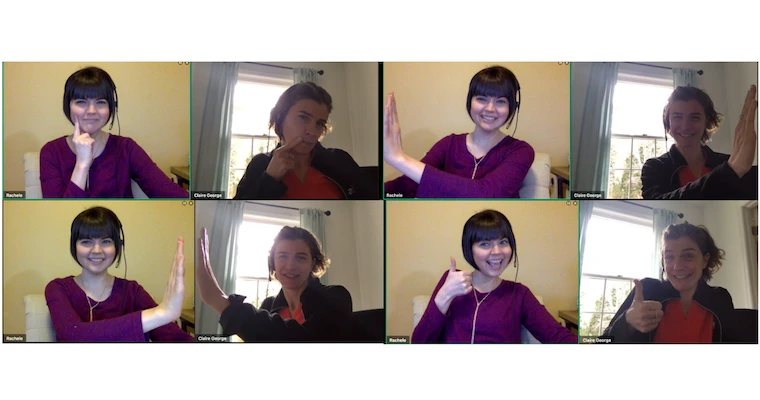
Remote Team Meetings vs. Office Team Meetings
“What do you mean you saw your co-workers? You work at home.” A friend who works for the county court system once asked me this with a look of confusion on his face. He knows that Aha! is an entirely remote company, but he was unfamiliar with the concept of remote meetings. I chuckled as I assured him that nobody had to fly into the Bay Area — we simply caught up over video conference.
Teams do not have to be physically in the same space to have productive and enjoyable meetings.
If you are unfamiliar with remote meetings or have not experienced a successful one, you might be skeptical. How can you possibly make progress on goals and forge enduring relationships when you are not in the same room as your co-workers (or your customers)?
Well it is possible — if you hold all meetings over video. This is what allows distributed companies to be highly productive. Even as our team at Aha! has grown to nearly 100 people, we have continued our commitment to productive remote interactions.
Besides our all-hands company meeting every Friday, functional groups hold their own meetings, managers hold weekly 1:1s, and most teammates hop on a video call or two throughout the day to discuss a project or talk through a challenge.
The real issue is not that people are skeptical of remote meetings. Most of us doubt the value of any type of meeting — in-person or remote.
I understand why. Meetings can be a waste of time and energy. According to a recent study, poorly organized meetings do more than waste participants’ time. They also reportedly cost the U.S. economy $399 billion in lost productivity. This is why it is vital that you know how to focus and structure your meetings for success.
While Aha! depends on virtual meetings as an entirely distributed company, I know there can also be real value in the office version. Here is how the common assumptions about in-person meetings stack up to the reality of remote video meetings.
Connection Office — When co-workers are physically in the same space all the time, it may seem easier to feel closeness and camaraderie. This can lead to stronger collaboration during meetings and make it easier to rally the team around a new goal or project.
Remote — With no opportunity to bump into folks around the office, it simply takes an intentional effort to connect. Everyone at Aha! gets on camera so we can see each other’s faces and forge meaningful connections. We also devote a bit of time to small talk, jokes, and catching up on each other’s lives.
Trust Office — Being co-located helps with reading nonverbal cues. Shifts in eye contact, facial microexpressions, or subtle body movements can reveal more about what a teammate is thinking or feeling than their words alone. Recognizing these communication cues increases trust and may reduce the risk of misunderstandings. Human beings are simply better able to recognize those subtle expressions in person.
Remote — Video is not as good as being in the same room, but it comes very close. It allows teammates to build close bonds and foster feelings of trust. You do miss out on some nonverbal cues because of the ever-so-slight delay in most web conferencing tools. At times, that micro-delay can result in people talking over each other. Once you get the hang of it, this is less of an issue. Plus, it helps remind you to slow down and speak intentionally.
Focus Office — When everyone is gathered in the same conference room, there is more accountability for people to pay close attention to who is speaking. After all, it is difficult to zone out or multitask when surrounding co-workers can see and hear you. But office meetings also bring their own distractions — people hovering outside waiting to use the conference room or executives dropping by to share an unexpected update.
Remote — Likewise, home offices can be just as distracting when the doorbell rings or the dog starts scratching at the door when you are presenting to the team. This is why we encourage as many people to share their webcam as possible. Beyond that, our team stays focused with meeting agenda templates. Everyone knows what to expect and who will be presenting — clarifying why we are meeting and what we will accomplish.
Transition Office — How long does it take you to switch to other work after a meeting ends? In-person meetings can lend themselves to extra chit-chat as people linger or delay returning to their desk. And if you factor in travel time between or within buildings, it can be several minutes (or longer) before you are able to get back to work.
Remote — Video meetings remove the need to travel between conference room and desk. Because our team works in the same place that we have meetings, we experience less transition time and a smooth return to productive work.
Office meetings can connect teammates and drive the business forward. But remote meetings can accomplish this just as well.
Location is not the key differentiator. Whether you work in an office or remotely, you can always improve the meetings at your organization. Suggest that the team adopt an agenda or designate a notetaker to record action items. And make sure you participate by offering ideas, questions, and insightful comments.
Meetings are all about coming together to create something better than what any one person could accomplish alone. The best part? You can be anywhere in the world while you do it — no plane ticket required.
What do you think is the difference between in-person and remote meetings?
Remote workers are happier and more productive. Find out for yourself — Aha! is hiring.




